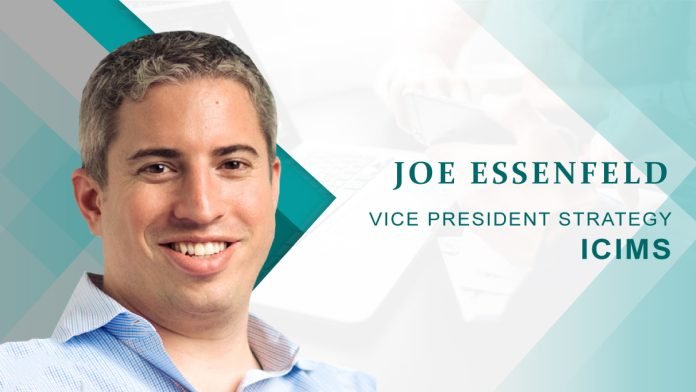Joe Essenfeld, Vice President of Strategy, iCIMS discusses a spectrum of HR and technology-related scenarios, strategies, and suggestions that empower the HR industry
1) Tell us about your role in iCIMS?
I joined iCIMS in 2019 and currently serve as the vice president of strategy. In this role, I am focused on building partnerships with strategic companies to help shape our product strategy and roadmap. I’m uniquely positioned to identify and build relationships with market-leading companies that help the company as we continue to lead with our innovation and scale.
2) Can you tell us about your journey into this market?
Prior to iCIMS, I spent some time in the food service business, where I franchised a restaurant and also served as COO of Insomnia Cookies. Through those roles, I received first-hand experience in recruiting people, building teams, and using various tools to do those two things.
I noticed that there were many gaps in the employer and candidate experience and felt there was a lack of innovation in the space. So, I founded a company called Jibe in 2009 to improve the candidate experience and recruitment marketing, specifically the career site experience and CRM capabilities, to remove the friction in recruiting and finding a job. As CEO of Jibe, I spent a decade helping some of the world’s largest employers tackle their hiring challenges. Then, in 2019, Jibe was acquired by iCIMS, and I have remained with the company to continue my quest of improving the job search and hiring processes.
3) Can you talk about how you think technology is changing the HR sector?
Technology is changing the HR sector – and many other business functions and life – at a faster pace than ever before. A crisis tends to accelerate the adoption of new technologies, and this pandemic is teaching us many lessons around doing so successfully.
We are currently living in what we thought would be “the future of work” a few years down the road, but we were introduced to it in just a few short weeks.
Many companies have accelerated their innovation out of sheer necessity to keep their business running, and as a result, a lot of the actual ergonomics and comfort of new technologies had to be deprioritized just to get work done.
As we continue to plan for the new future of work, it’s going to be about optimizing processes and technologies to accommodate how we are currently working. After the pandemic, I believe we are going to keep the “work from anywhere” philosophy. With that will come many challenges, but we must adapt, and we will likely see technology get more personal as we discover how we can work together in more efficient ways.
Here are two quick tips as you consider new technology and how it can impact your organization:
- A strong partnership between the CHRO and CTO is essential in driving change and removing barriers with technology. My advice to talent and tech leaders is to look at the technology that your company is deploying, most reliant on, and seeing success with, and think about how you can integrate your HR and talent acquisition processes with it. For example, if your employees mostly operate in Microsoft Teams, figure out how to get more work done within that platform and increase efficiencies within Teams vs. requiring your talent teams to pop in-and-out of browsers and other platforms. When your new technology is integrated into the flow of work in your organization, you will get the best ROI and will be well-positioned for 2021 and the next few years.
- When evaluating new tech, it boils down to quality of a relationship. Don’t buy new technology for fancy features and functionality alone – instead, find technology companies that will be your consultant and your partner, and will help you lead through the pandemic and beyond. Prioritize vendors that prioritize innovation. Their ingenuity will help guide you in this new era of work.
4) What do you think is the significance of recruitment marketing to nurture the right-fit candidates?
The “right fit” candidate is someone who can fill the role you need today and grow into the role – or roles – you will need in the future. With that, you may need to look beyond a candidate’s letter-perfect resume crafted to meet your current job description.
- Expand your reach beyond the external candidate pool all together and consider internal employees with untapped potential.
- Craft job postings for the people you want to hire and not just the job you need someone to do.
- Showcase your company culture and values on your career site: highlight actual employees to give a candidate an idea of workplace “fit.”
- Extend an authentic view of your company through your CRM email campaigns and recruiting events and remain focused on finding the right people for your company, not just the right people for a specific job posting.
The bottom line with recruitment marketing is engaging with candidates that you are interested in, so they remain interested in working with you.
5) What role is AI playing in candidate engagement?
AI is fueling HR’s transition from administrative to strategic to mission critical. The use of conversational AI specifically is helping organizations extend engagement with global talent, while scaling real-time and personalized hiring experiences. The use of AI with intelligent task and process automation will continue to be deployed to drive process and cost efficiencies. AI also allows us to better understand and get value from the massive influx of data we capture daily. The spin off effect of this is to be able to look at the data (a prospective candidate’s project experiences, industries served, etc., for example) and help predict hire outcomes with the use of virtual assistants/chatbots, candidate and job matching and recommendation engines.
AI technology, including intelligent chatbots, are going to do for CHROs what cloud computing has done for CIOs – provide reliability, flexibility, and scale to address higher applicant volumes and the starts and stops in hiring most are facing now. In the first half of 2020 alone, our customers set up double the number of interviews via a chatbot than it did in all of 2019, and leveraged conversational AI to engage 50% more applicants than this time last year.
6) How can firms efficiently rehire the employees furloughed due to the pandemic?
The strategy for rehiring previous employees and connecting with new candidates is one in the same – create a personalized, open and honest line of communication. Use technology to scale offer letters and onboarding to accelerate time to productivity.
7) How do you think virtual recruiting can scale diversity and inclusion?
Data proves that companies are more profitable and run more successfully when they have diverse teams and workforces. Last year, the labor market was tight, and many companies were struggling with diversifying their workforce. Fast forward to today, where there is a lot of volatility in the labor market, and the pools of available talent are now much wider.
We are encouraging our customers that have diversity plans in place to start sourcing and building more diverse talent pipelines now, even if they are in a temporary hiring freeze, so their talent pools are nurtured and engaged in the company, for when they are ready to pick up hiring again.
Virtual recruiting can also open new doors to candidates who might be unable to travel due to socio-economic disadvantage or disabilities. In fact, hiring data from our platform shows that there’s a consistent uptick in out-of-state job applicant activity. It is evident that with geographic location no longer serving as a leading job qualification for many employers, organizations are now receiving an influx of job applications from new talent pools. More applicants, fewer resources and remote work arrangements increase the complexity of the hiring process.
The realities of how we are living and working today had opened employers’ eyes and fueled many changes, including their openness to tap into talent by expanding location and lowering the barrier to entry. Virtual recruiting can help to level the playing field and give candidates an equal opportunity to attend a career fair they might have previously overlooked since they can now participate virtually.
8) How do you prepare for an AI-centric world?
AI capabilities and “robots” should not replace human functions but should improve and enhance human-led decisions.
Companies who embrace and understand the power (and limitations) of modern technology, like AI/ML, will succeed and outpace their competitors.
9) What are the major developments you are planning, in recent times?
Right now, we are focused on innovating in areas that deliver the most impact and value, especially in this virtual, complex, and changing world. One partnership that I am working on right now and really excites me is with Microsoft. We’re working on a workplace collaboration integration between our talent acquisition platform and Microsoft Teams. This integration provides greater efficiency and collaboration, especially as many teams are working remotely or in hybrid work environments. Now, our customers will be able to conduct interviews and provide quick feedback all within Teams, without needing to jump into the iCIMS platform and disrupt their normal flow of work. This functionality is a game changer as companies continue to find ways to remove barriers, improve the user experience and speed up time to hire. Our chief strategy officer, Michael Wilczak, recently shared his perspective on the meaning of teamwork and our partnership with Microsoft Teams, which you can read on LinkedIn here. This integration was also recently recognized as a “Top HR Product of the Year” at the virtual HR Technology Conference.
10) Which Book are you reading these days?
I just enjoyed “Skin in the Game” by Nassim Taleb – his commentary on understanding and avoiding fat-tail risks so you can more comfortably increase risk tolerance is a useful framework for investing and pushing the envelope of innovation.
11) We have heard that you have a very joyful work culture, we won’t mind having a look at some of the pictures?
As the talent cloud company that empowers organizations to attract, engage, hire, and advance the right talent, we know the importance of bringing together the right talent with the right teams to yield business success. We extend the same sentiment when building our own teams at iCIMS. Over the past 20 years in business, we’ve cultivated a one-of-a-kind company culture of team members from across the globe who respect, support, celebrate, and learn from one another, while making a significant impact on our customers, partners, business and on each other.
We have a hard working, but enjoyable culture, that is defined through diversity and inclusion and amplified by our core competencies: accountability, adaptability, customer commitment, drive, empathy, kaizen, passion and transparency. I’m proud that even as we transitioned to a 100% virtual work environment in early March, we haven’t skipped a beat, and our culture has remained supportive and engaged, partially due to the agile technology and processes we already had in place to set us up for long-term success.
12) Can you give us a glance of the applications you use on your phone?

For more such Updates Log on to www.hrtechcube.com

Joe Essenfeld Vice President of Strategy, iCIMS
As Vice President of Strategy, Joe Essenfeld is focused on building partnerships with strategic companies to help shape iCIMS’ product strategy. He plays a vital role in helping the company scale, as he identifies and builds relationships with market-leading companies to build differentiated products and distribution channels. Essenfeld recently led a team of volunteers to produce an app, AllClear, to help people find COVID-19 testing locations, based on location, insurance needs, etc., and provide users with contact information and directions to make testing more accessible.












